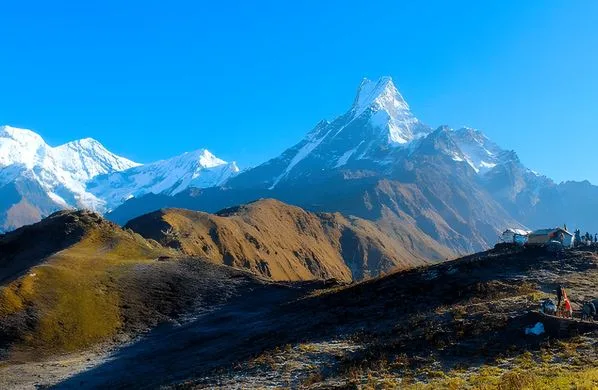Health and Saftey Tips for Mardi Himal Trekkers: Altitude, Hygiene, and First Aid
Mardi Himal short trek is one of the best treks in nepal. The trek takes you through beautiful snowcapped mountains, lush vegetation, and deep valleys with rich culture and heritage. The trek is a moderate-level trek. Hence, the trek caters to visitors of every skill and age. The simplicity of the routes decreases the chances of accidents and risks significantly but doesn’t dissipate them completely.
Trekking itself is a physically taxing adventure activity; trekking through rough and rugged surely isn’t easy. Although the Mardi Himal short trek seems to be an easy journey to conquer. Trekkers shouldn’t underestimate the journey as things might get unfavorable for you at any moment. Trekkers must have detailed information about the trek and must plan accordingly to deal with the possible health risks and accidents that might occur during the trek.
There is always a possibility of health risks when you go on such journeys but
prevention is always advisable rather than cure. Hence you level up your stamina and fitness, consult with your doctor, and take safety measures. Since there aren’t many hospitals along the hiking route, having travel health insurance that pays for both emergency medical care and evacuation is essential.
Health risks and safety tips on the Mardi Himal trek
The Mardi Himal short trek takes you to an elevation of 4500 meters where quick medical assistance is near impossible. In this article, we will go through the possible health hazards, how to prevent them or cure them in cases of emergency, and how to maintain hygiene in the Himalayas. So make sure you read until the end.
Physical injuries
The Mardi Himal short trek takes you through a rough and rugged trail where inconveniences and injury might occur at every turn. Although the journey is a moderately difficult and short one it is still a strenuous task to trek the region. Hence it is very important to maintain good physical fitness and stamina when you go for a mardi himal short trek. Physical injuries like ankle twists, strains, and sprains in rough terrain can be prevented by being mindful and alert to conquer the trek smoothly. Some other ways to prevent physical during the trek are as follows.
- Wear high-quality and sufficient footwear and ankle support to prevent any sprains or strains during the trek.
- Take regular breaks and stops during the Mardi Himal short trek and make sure you are stretching before you resume your trek to warm up the joints and musculature of the body
- Prepare your first aid kit with all the necessary items which will assist you in any emergency.
- In case of any severe emergency be composed and calm and take the pre-planned necessary steps
- Plan your route and itinerary according to the weather and other external factors since the chances of physical injury also increase significantly due to external factors
Altitude sickness
The Mardi Himal short trek is a trek in high altitudes so altitude sickness is quite prevalent when you ascend to higher elevations. Altitude sickness occurs when your body is unable to adjust to the low level of oxygen in higher altitudes. It is also referred to as acute mountain sickness in medical terms. This is caused due to rapid ascent, poor acclimatization, or personal health issues. The early symptoms show dizziness, headache, nausea, insomnia, and loss of appetite. If not treated in time it may lead to High-altitude pulmonary edema and high-altitude cerebral edema which are life-threatening conditions. Some of the ways to prevent or minimize the risk ko altitude sickness are as follows.
- Make sure you are drinking plenty of water, and giving your body enough time to adjust to the altitude by ascending slowly and getting familiar with the atmosphere.
- Consult with your doctor and get some prescribed first aid medication such as Diamox for altitude sickness
- Eat nutrient-rich foods full of protein carbs and healthy fats which will provide you with energy and help you fight altitude sickness as well
- Use various acclimatization techniques to adjust your body to high altitude. Ascending to a higher altitude during the day and descending to a lower altitude to take a rest is one of the popular acclimatization techniques used by trekkers.
Dehydration
Traveling through the Mardi Himal short trek is a physically daunting task. Hence proper hydration is very important to conquer the trek. Dehydration is the main reason that poses a serious Health hazard in the mountains. It is caused when the body is constantly losing fluids and the body is unable to retain enough fluid to carry out normal bodily functions. The early symptoms of dehydration are dry mouth, headaches, weakness, and dizziness. Neglecting dehydration during your journey might lead to severe health issues like renal failure, and heat stroke the person also might lose consciousness at times. Dehydration is also prone to altitude sickness. some ways to prevent dehydration are as follows
- Get the optimum amount of water inside your body. Drink water frequently throughout your journey make sure your water consumption is 3 to 4 liters a day
- Do not consume caffeine or alcohol during your journey because these drinks severely assist in dehydration
- Consume foods high in water content which are specially fruits and vegetables
- The water bottle must be an essential item you carry along. You must also carry filtration and purification pills to treat the unsafe drinking water.
Hygiene
Hygiene is the most important thing when you are trekking the Mardi region. Keeping good hygiene ensures comfort, health, and well-being which will make the journey pleasant and fun. When you are out in the isolated terrains it’s hard to maintain personal hygiene. Hence during your journey, you must find hacks or ways to stay clean and hygienic to save yourself from various diseases and sicknesses. Hence you must travel with top-notch hygiene to make the journey smooth and pleasurable. Here we list down ways as to how you can maintain your hygiene in the Himalayas down below.
- Various infections, diseases, and illnesses spread through your hands. So make sure you wash your hands with bio-degradable soap every chance you get. In cases of water scarcity, you can use hand sanitizers and wet wipes to clean your hands.
- Do not drink water from any water sources as there is always a risk of contamination in those water resources. Even if you are drinking water from unsafe sources make sure you use various filtration and purification processes or carry a water purification pill.
- Hygiene for female trekkers is very important because they need to handle particular difficulties like menstruation and urinary health. So to properly manage menstruation throughout the journey, bring tampons, pads, or menstrual cups, depending on your preference.
- Remember to carry an extra set of undergarments to save yourself from any trouble during your menstrual cycle. Since it is not possible to wash your sweatpants while trekking so be careful.
- Examine the food’s freshness and quality and also opt for businesses that follow appropriate hygiene standards, and food hygiene.
- Using forks and spoons rather than your hands is one of the recommended hygienic practices when trekking. This lessens the need to use water for cleaning and keeps illnesses out of your mouth.
- Maintaining hygiene in surroundings is as important as personal hygiene so use-biodegradable toilet paper after excreation. Because water slows down the breakdown of fecal waste, its usage is prohibited. Also, dispose of toilet paper away from the campsite.
- Ensure that your inner layers are changed daily to avoid body odor and perspiration accumulation. Remember to always have spare pairs of inner layers on hand in case you get sick or infected.
- To avoid an unpleasant odor from your foot, make sure to take off your shoes and socks at least once a day. Give your feet room to breathe. You can wash your feet or wipe them with talcum powder or anti-fungal powder to clean them and get rid of any dirt or odor.
- Keep your mouth clean. Use a high-quality toothbrush and toothpaste. Don’t forget to bring a tiny towel and mouthwash for perfect dental hygiene.
- Wet clothing can harbor bacteria and moisture, which raises the possibility of health risks. So keep your body clean. Bath whenever you get a chance or use wet wipes for a dry bath in case of no shower. Also, Avoid using deodorant.
Conclusion
The Mardi Himal Base short trek is one of the easiest and fastest ways to explore the Himalayan wonders of Nepal. But health and hygiene must be a top priority before you take on any sort of trek. Proper planning and preparation can save you from mishaps that might occur during your trek. So being well aware of the health risks and having a well-stocked first aid kit on hand is crucial because emergencies can happen at any time.
In addition, before leaving, speak with your doctor about recommended medicines related to other health issues. All things considered, a safe and enjoyable trek to Mardi Himal can be achieved with the right planning and safety measures. Make sure you maintain your safety and well-being before you take on the majestic Mardi short trek to the Himalayas of nepal.





